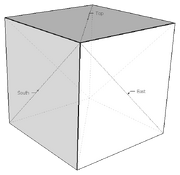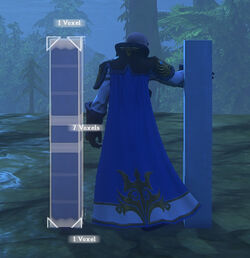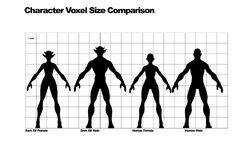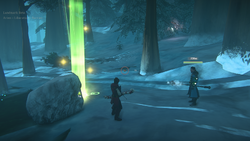Launch and Voxels[]
Many of the terms associated with this topic changed by launch. For example, Daybreak Game Company, LLC now refers to voxels as blocks, to offset any confusion about how and why they can be altered. Some of the techniques described are now achieved using the normal building tools. For example the drop-down options Fine Tuning replaced many techniques, including "pasting with/out air"). The need for "putty" was replaced by the Fill Tool. Even so, this information is largely left in-tact as it may serve in understanding how and why certain techniques can be achieved.
The word voxel is often used casually in Landmark as a unit of measurement equal to the smallest cube that can be placed with the Add Tool, but this is not a truly accurate way to define voxel.
Pre-Launch Information[]
The information below contains the technical definition of voxel and key information that may help some players understand why they see certain changes while using Building Tools. Do not be put off by the technical information; anyone can learn to build in Landmark with practice. Often, using the building tools and experimenting is enough for many players to gain a solid understanding of how voxels behave.
Introduction[]
In Landmark, Voxel or Volumetric Pixel is a term for units of information describing all visible shapes in Landmark (e.g. buildings, terrain). The game's editing tools allow players to place and remove shapes of varying sizes defined by voxels. Additional tools allow players to smooth, form, and otherwise customize these shapes.
Voxels also uniquely allow for the active destruction of material into its component pieces on the fly, a significant component of Landmark. A visualization is available here, where the shape is green and the voxels are outlined in white.
Voxels[]
A voxel may represent one vertex and one material. Voxels can be thought of as cubes stacked in a 3 dimensional grid, like the blocks of a Rubik's cube. These are not the cubes you can stack with the Add Tool (see the Shapes section below).
A voxel's vertex, if assigned by the player using a tool, may be up to 1.5 widths of the cube from the center of the cube in any axis (in other words 1.5 vx up or down, north or south, and east or west). Another way to look at this is if the voxel is the center of a Rubik's' cube, the vertex may be anywhere in the Rubik's cube's volume. A voxel's material contributes to how one of the adjacent shapes' textures are rendered (e.g. wood, stone, dirt).
A voxel doesn't necessarily contain a vertex or material. Voxels exist in layers, and when a voxel doesn't contain information, the information is derived from another layer, (i.e. the environment, or the voxels you're pasting over). In most cases this places the vertex in the center of the voxel's cube and the material as either air or dirt, but other materials and vertices may be assumed at naturally occurring surfaces.
Shapes[]
When you use the Add Tool at it's smallest size, a shape takes the form of the eight voxels the tool is used on (the 8 vertices of the shape). The shape can be deformed, and this makes them useful for building various structures. These make up the structures you see in the world.
Anatomy[]

Illustration of voxel face triangulation
Vertices are connected by edges to vertices of voxels that are adjacent in the 3 dimensional grid. They are also connected by edges to vertices to voxels to the upper south, lower north, south east, north west, upper east and lower west. This means that the faces of shapes are composed of triangles that are divided in an orientation specific way. The division of the sides of the shape (such as a cube) into 12 triangles (2 per face) is called triangulation.
A shape has one material determined by a voxel containing one of its vertices (most likely the top south east corner of the shape). The material contributes to the texture for all visible sides of the shape. Materials for adjacent voxels may contribute as well, and when they do it is called blending. Air can be considered a material that is not rendered. Water is a transparent material whose texture is animated. Only the outside of each face is rendered, and only if the adjacent voxel is transparent (such as air or water).
Modification[]
Each shape shares faces and vertices with adjacent shapes. If you modify the right side of one shape, you modify the left side of the shape to its right.
When a copied shape is rotated 90 degrees and pasted, the vertices of the shape it is pasted over move to match the rotated vertices of the shape that was copied, but the triangles will always be divided top-south-east to bottom-north-west. This means that a shape's form is not preserved after rotation.
When you use the Delete Tool on a shape it changes the material to air and assigns the top-south-east vertex of a shape to the center of the voxel defining that vertex.
A shape's material can be changed to any material except air by the Paint Tool, but this does not affect it's shape.
A shape's form may be partially assigned by the player, that is it may be assigned zero to eight vertices. The positions of the rest of the corners will default to the corresponding vertices of the voxels in the environment before the land was claimed or modified by a player.
A shape also may or may not have a material assigned by the player. If the material is not assigned by the player then the material will default to the material of the corresponding voxel in the environment before the land was claimed or modified by a player.
More information about Basic Voxel Editing is available.
Measurement[]
Measuring in Voxels[]
| voxel | inches | feet | centimeters | meters | marks |
| 1 | 9.6 | 0.8 | 24.4 | 0.2 | 0.4 |
| 10 | 96.0 | 8.0 | 243.8 | 2.4 | 4.0 |
| 100 | 960.0 | 80.0 | 2438.4 | 24.4 | 40.0 |

Character Size

Race Size Comparison Chart
Using our building tools, we are able to add material of a standard size to the world. A 1x1x1 square of the smallest amount of material is considered a "voxel" in size. Using the Selection Tool, players can measure distances in Landmark in units of voxels. For example, a claim is a box 175 voxels wide by 175 voxels deep by 250 voxels high.
Voxels can be compared with real-world units of measurement, allowing players to build objects to scale.
See the Build Sites page for the measurements of build sites.
Measuring in Marks (/Loc units)[]

Distances, measured in Marks
| mark | inches | feet | centimeters | meters | voxels |
| 1 | 24 | 2 | 61.0 | 0.6 | 2.5 |
| 10 | 240 | 20 | 609.6 | 6.1 | 25.0 |
| 100 | 2400 | 200 | 6096.0 | 61.0 | 250.0 |
Beyond measuring in voxels, players can type /loc (or /location) to determine their exact position in the world. The world grid is measured not in voxels, but on a different arbitrary grid system designed by the developers. Distances between waypoints, targets and party members are measured using this unit, and displayed with the letter "m".
"m" does not stand for "meters".
Landmark is a foreign world, and it is only natural that the residents would not use a system of measurement based on Earth[1]. Each "m" marks out a distance of 1 /location unit, called a mark. Conveniently, each mark is a distance of 2 feet (0.6096 meters).
A Landmark island is a grid of 8,000 x 8,000 marks. This comes out to 3x3 miles (4.9 x 4.9 km) in size. In terms of depth, each island is now more than the previously claimed mile in height[2]. The floor of each island is -2,000 marks, and the ceiling is 2,000 marks, making for a total height of 4,000 marks or 1.5 miles.
Player Names for Shapes[]
NOTE: Most of these names preceded David Georgeson's explanation of voxels. Prior to that the term "voxel" was used to refer to what is now called a "shape".
Micro Voxel[]
(aka MV, aka Pip)
- Micro-voxels behave like normal shapes but are much smaller. Generally a micro-voxel refers specifically to a shape that is uniformly compressed on all sides.
Anti Voxel []
(aka AV, AV etching, etching)
- Anti-Voxel is a term applied (erroneously, since it is a method, not a shape) to shapes created by a different number of techniques and imprinting that all involve creating and manipulating shapes that appear to be partially air. The shapes themselves, however, are merely partially compressed shapes that behave like regular shapes. Named distinction should only be applied to the air-shapes created which can be embedded via Etching (see below).
Anti-Voxel Etching []
(aka air etching, etching)
- This is the technique that uses the creation of a partial-air shape to embed air into a regular shape and thus create an "etched" form.
Voxel Strings []
(aka anti-voxel strings, av strings)
- Voxel Strings are shapes that have been manipulated so that they are the same length as a voxel along one or two axes, but are smaller along a third axis. If they are smaller in only one axis, they may be called Voxel Planes.
Zero Data Voxel[]
(aka ZDV, healed earth/healed air voxel, procedural earth/procedural air voxel)
- Zero Data Voxels are shapes that have no player assigned material or vertices (thus zero data). These exist in the clipboard when copied from untouched procedurally generated terrain or in some cases shapes that have been healed using the Heal Tool (3x3x3 selection around that shape when healing guarantees it). Painting them will assign a material, making them a Putty Voxels. Since they don't have a player assigned material, they don't assign a material to a shape when pasted. Zero Data Voxels are very useful when making inlays or pasting items without the accompanying air.
Putty Voxel[]
(aka painted air, voxel putty, voxel filler)
- A shape that has no player assigned vertices, but does have a player assigned material. These shapes can be copied directly, and when pasted do not modify any adjacent shape's vertices. They do assign the material. The use of Putty Voxels is much like painting, except that Putty Voxels can alter the material of air without changing the form of the air's shape, and they they can be pasted more than one at a time. They can be created by painting a Zero Data Voxel that has no corners assigned (which is normally the case when surrounded on all sides by other Zero Data Voxels).
Zero Volume Voxel[]
(aka ZVV, slivers, tape)
- Shapes that have no volume. They have also been called slivers or tape. These shapes do have a material that can blend with adjacent shapes, they are often invisible from some or all angles, and they do deform adjacent shapes when pasted. If another shape is pasted or added next to one of these shapes, the Zero Volume Voxel may be deformed in a way that gives it a volume (thus no longer being a Zero Volume Voxel).
Video[]
Community member Voidlust, created a video series to introduce some of these concepts to players.
